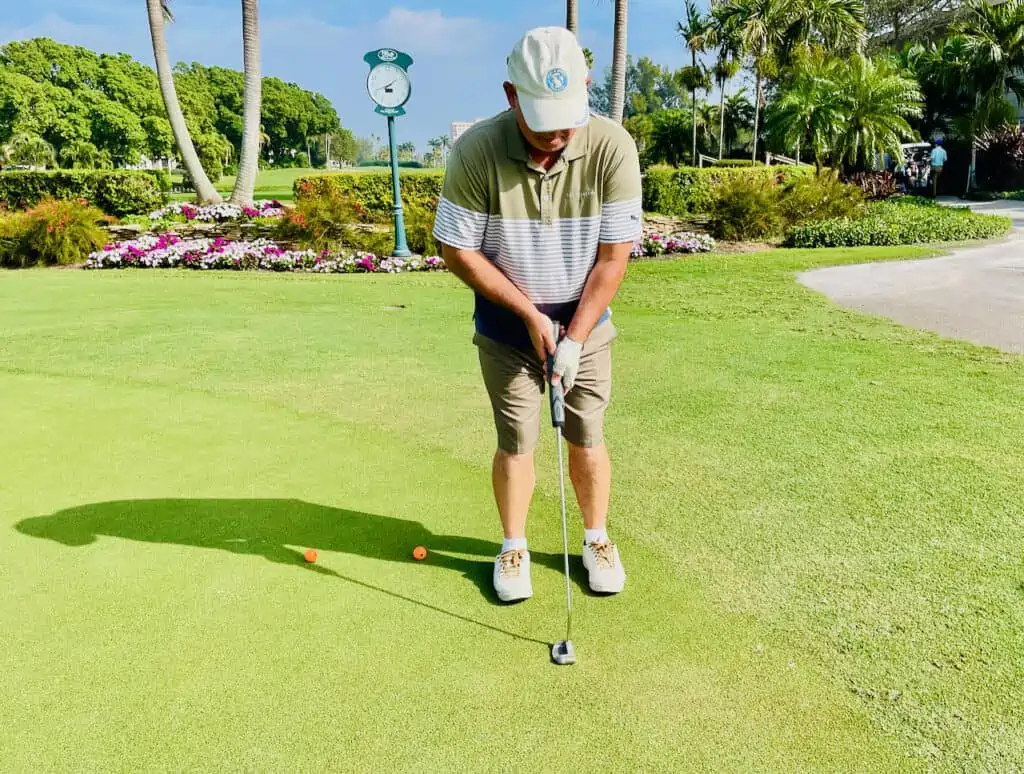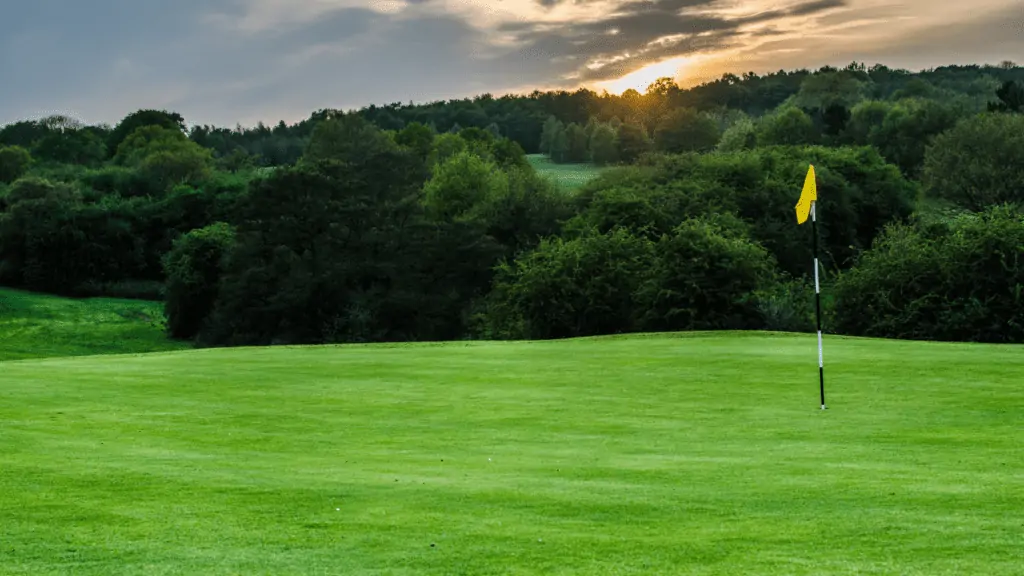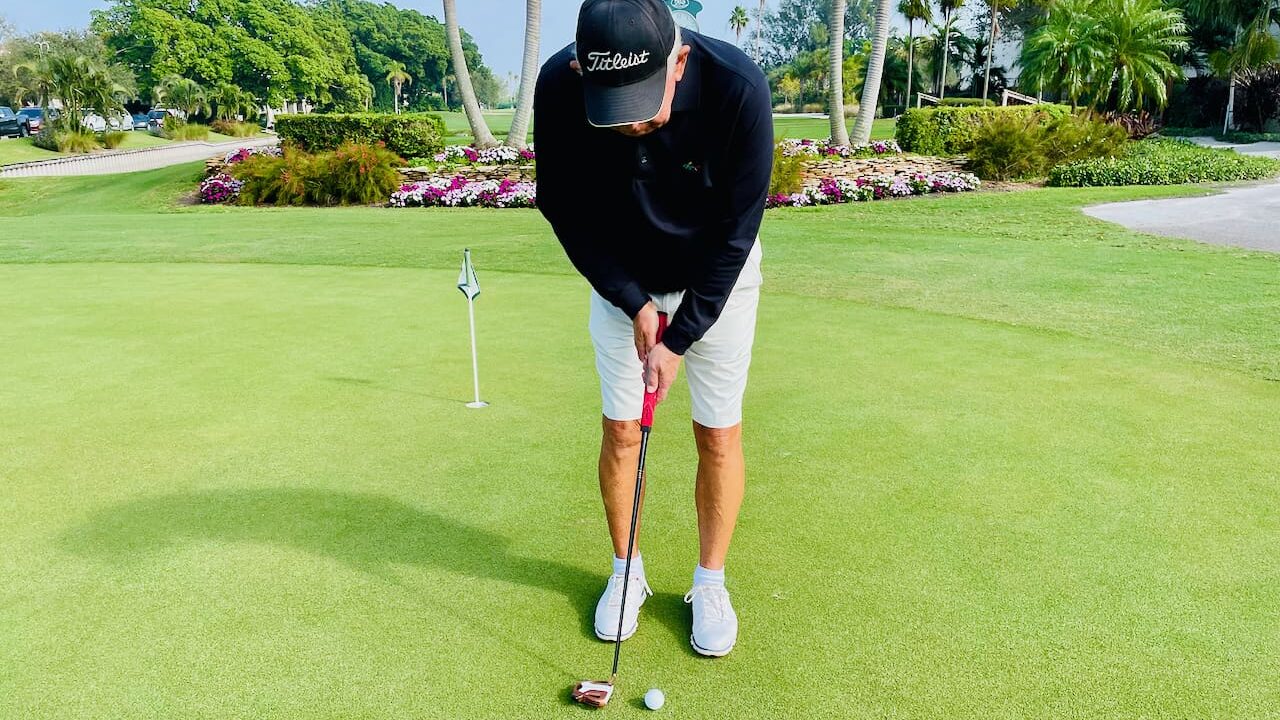Table of Contents
Ever tried the cross handed putting grip (left hand low putting)? In this article, we break down the pros and cons and which famous golfers love it!
Golfers are constantly coming up with new techniques to improve their game, and with good reason.
Golf is a challenging game to master, and any change in technique, equipment, or otherwise that could bring the slightest improvement should always be taken up.
Here is a famous funny golf quote that sums it all up:
“Half of golf is fun. The other half is putting.” 😀
– Peter Dobereiner
Putting can be a game changer if gotten right. It can also be the bane of your golfing existence if you struggle with technique. With putting, there are ideally very few moving parts, and a lot of going right or wrong depends on your golf grip.
Among the grips that have since long been at the forefront of putting excellence is the left hand low grip, otherwise known as the cross handed putting grip.
In this article, we’ll be looking at how the left-hand low-putting grip could help you improve your putting and also how it might actually affect it adversely, depending on your putting stroke.
⛳️ Read Next: 8 Best Putters For Left Hand Low (Cross Handed Putters)
Quick Summary: Pros and Cons of Left Hand Low Putting
Do the pros recommend it? What drawbacks might it have? Read on to find out! Short on time, here is my quick summary table.
| Pros | Cons |
| Better alignment | Less feel |
| Increased stability | Not suitable for all grips |
| Softer grip pressure | Greater swing-arc |
| Higher reliability | Short backswing |
How Crucial Is Your Putting Grip for Success?
Just like for any other golf club grip (Driver, Irons, Chipping, etc.), the putting grip is one of the most important fundamentals and affects your putting more than you think.
When over a third of the strokes in your round of golf come from putting, it would be smart to work on this area the most.
“If people are upset with being a 25 or 36 handicap, just watch them putt. It’s the fastest area in the game to save 5 shots per round,”
– Dan Schwabe, PGA Tour, Professional Golfer
Since your golf grip is the only part of your body that’s in contact with the putter, and it is what makes the putter do what it does, it’s best to find the grip that works best for you.
That, indeed, is the best golf grip there is. The one that helps you sink more putts!
⛳️ Read Next: Expert Putting Tips & Drills for Senior Players

5 Common Putting Grip Styles

Here are some common putting grip styles that golf players use: conventional, claw, prayer, arm lock, and left hand low. Let’s now take a closer look at each of these putting grip styles.
1. Conventional or Normal Grip
It’s the most common style with which golfers grip the putter. Famously, it’s the grip Tiger Woods has used throughout his golfing career.
It’s a standard grip that is much like how all clubs in the bag are gripped. In the conventional style, the right hand is below the left with both hands on the putter.
2. Putting Claw Grip
The putting claw grip is the most non-traditional grip. The dominant hand claws the putter from the bottom of the grip while the wrist of the other hand locks in place on top.
This allows for minimal club-face dispersion through the putting. Chris Ryan, PGA Coach on Today’s Golfer, demonstrates the claw grip for putting.
Putting Claw Grip Demonstration:
3. Prayer Putting Grip
The prayer putting grip is also known as the palms facing grip.
For this grip, instead of one hand being above the other, both hands meet at the same point on the grip and lock together snuggly.
This helps most when you feel the putter is wobbly through the putting stroke.
Prayer Putting Grip Demonstration
4. Arm Lock Putting Grip
The arm lock putting grip involves using a putter with a longer shaft than a standard putter.
You utilize the longer shaft by bracing your weak arm against it for increased stability. You’d feel like some shaft-lean is involved in keeping the shaft braced against your arm.
Arm Lock Putting Grip Demonstration
Check out the below video that demonstrates the arm lock putter and choosing the best grip technique.
5. Cross Handed Putting Grip
The cross handed putting grip is also known as the Left Hand Low grip. That’s exactly how it works.
Your left hand (if you’re right-hand dominant) drops down from the conventional grip and grips the putter from below the right.
Fun Fact: Jack Nicklaus says if he could go back and change one thing about his game, it would be to use the left hand low putter grip.
Coming from one of the absolute greatest to ever play the game, that’s a great endorsement and should be a point to consider for any golfer.
How To Do the Cross Handed Putting Grip? 3 Easy Steps
Here are a few quick steps to get started with a cross-hand putting grip.
- Start by gripping the middle of your grip with the left hand. The back of the hand is facing the target line, and the wrist is in a weak position. This will limit rotation in the joint and produce more stability.
- Your left thumb should, although seem to be going down the center of the shaft, it should be slightly to the left on the grip.
- Place your right hand above the left, and try to replicate the left hand’s grip except with a strong wrist position compared to the weaker left wrist.
Cross Handed Putting Grip Video
Once you have the basics down, you may want to watch this quick of the cross handed putting grip demonstrated by US Golf TV.

What Are the Advantages of a Cross Handed Putting Grip?
Here are some of the advantages you’ll attain using this grip.
1. Better Alignment
The shoulders naturally fall in line and square up when using the left hand low grip. This gives you a more squared stance and, in turn, better accuracy at address.
2. Increased Stability
With your right hand riding the back seat, the jerking it can produce is also significantly reduced.
The right hand now serves as the anchor, with the left making the stroke.
When you’ve got the putting yips, it’s usually because of the shaky right hand. The left hand low putting grip has often been used over the years as players begin developing signs of yips; this was a helpful solution to their putting woes!
3. Softer Grip Pressure
With your dominant hand now serving as the anchor and the left guiding the putter, the grip pressure is bound to get soft as your weaker hand is effectively doing the putting instead.
4. Higher Reliability
The various muscle groups, such as your legs and shoulders, are better utilized with this golf grip allowing for more consistency and reliability.

Disadvantages of Putting Left Hand Low

There’s no perfect putting grip. All grips have their strengths and weaknesses. Here are four drawbacks of using the cross hand putting technique.
1. Less Feel
With your dominant hand now serving as an anchor and your weak one being used to stroke the putter, you might not feel very confident with the pace with which you putt your golf ball.
But, like with all grips, it takes some getting-used-to, and you should stick with it for a while before deciding whether it’s working for you.
Speaking of feel, you should also verify your putter golf grip is right for you. While some may prefer the feel of jumbo golf putter grips, it’s not a one size fits all. When in doubt, get fitted by a professional to help you decide.
2. Doesn’t Go Well With Certain Grip Materials & Designs
Because of the unconventional nature of the cross hand grip, certain grip designs might be uncomfortable to handle using this grip. It calls for a more sturdy material, and the softer grip varieties might feel wobbly.
3. Greater Swing-Arc
The swing path of the putter tends to have a bigger arc, which isn’t favorable, especially for a straight-back-straight-through putting stroke.
4. Shorter Backswing (Not ideal for long putts)
This grip style also restricts your backswing. This may be favorable for shorter putts. But longer putts call for a longer backswing.
⛳️ Read Next: The 9 Best Counterbalanced Putters & Grips
5. Common Putting Mistakes
When using a cross handed grip it’s easy to make a few common mistakes.
First is unknowingly doing the “lefty lean” where you move your weight with your putting stroke, causing your left shoulder to be much lower than the right shoulder. This causes a steep angle and challenges with the golf ball roll.
Secondly, keep an eye out for not sticking your left elbow out from your torso. This is sometimes fondly called the “chicken wing.” This also will cause issues for you and will affect having a consistent putting stroke.
Refer to the video guidance provided to help alleviate any potential issues. And when you’re not sure, have a golfing buddy video your putting grip and stance. As they say, a picture is worth a thousand words!
Left Hand Low vs Conventional Putting
Here’s a short comparison table for the normal grip and the cross handed technique.
| Cross Hand Grip / Left Hand Low | Normal Grip |
| The left hand is below the right hand | The right hand is below the left hand |
| Switching to it might feel unnatural | Feels more natural |
| Better alignment | Locks wrist for better stability |
Professional Players Who Use a Cross Handed Grip
Yes, quite a few professional players use this putting style. Some of the more well-known golfers tend to think it feels more natural. Here are just a handful of golfers, in addition to Jack Nicklaus, who speak highly on putting stance.
Jordan Spieth is known for making this grip popular among modern golfers, especially the youth. He won big time in 2015 using the reverse grip, and he advocates and attributes it as one of the most common methods to success.
Dustin Johnson, another phenom in the golfing world and former world number 1, has been seen switching between conventional and reverse-hand grips from time to time.
Alex Noren also uses the left hand technique in his golf game.
Ricky Fowler was also quoted for saying that his cross handed grip helped him gain traction again on the putting green when his golf game had taken a slump.
Who Should Consider Going to Left Hand Low Technique?
This cross handed putting grip could work for anyone. Still, golfers struggling with the conventional grip should consider switching their hand positions and going left hand low putting.
It only makes sense that if you’re struggling with the right hand below, switching the left hand below the right could do some good. There’s no harm in trying new techniques in golf.
Final Thoughts: Cross Handed Putting Grip
The left hand low putting grip has undoubtedly got its upside and should be adopted, particularly by golfers struggling with the conventional grip.
The hold may be difficult to adapt because of the reversed grip and the shorter backswing could be a hindrance, especially on long-range putts. However, the pros outweigh the cons, so why not give it a shot?
Before You Go…
Don’t forget to read the 9 Best Putting Drills for Beginners to Master the Green. This has some excellent tips if you’re trying to shave some strokes off.
And, if you need a putter, you’ll want to read 8 Best Putters For Left Hand Low (Cross Handed Putters) next!

